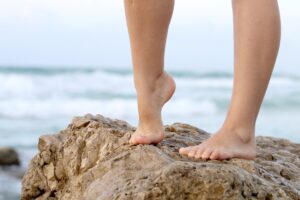How Are Varicose Veins Treated?
An estimated 25% of women and 20% of men suffer from anxiety and pain caused by varicose veins. Varicose veins can be not only unsightly but also uncomfortable, and often is associated with a larger vascular problem called chronic venous reflux disease. Fortunately, there are effective treatment options available.
What are Varicose Veins?
Varicose veins are diseased veins that usually occur in the legs and feet. These veins are responsible for carrying blood back to the heart, and they have one-way valves that normally only allow blood to travel to the torso while preventing the flow backwards to the feet. When these valves weaken or become damaged, blood can pool in the veins, causing them to stretch and bulge. Over time, these diseased veins become enlarged and appear as twisting purple veins under the skin.
Causes of Varicose Veins:
Several factors contribute to the development of varicose veins. These include:
- Age: As we age, the elasticity of our veins decreases, making them more prone to becoming varicose.
- Genetics: A family history of varicose veins increases the likelihood of developing the condition.
- Gender: Women are more likely to develop varicose veins due to hormonal changes during pregnancy, menopause, and the use of hormonal birth control.
- Prolonged sitting or standing: Occupations that involve long periods of sitting or standing can contribute to the development of varicose veins.
- Heavy lifting: Repeated lifting is associated with increased abdominal pressure that pushes blood back towards the legs, forcing blood against these veins and into the veins.
Symptoms of Varicose Veins:
It is a myth that varicose veins are only a cosmetic issue. Varicose veins are a commonly misdiagnosed cause of significant symptoms. These symptoms include aching or heaviness in the legs, making it difficult to carry out daily activities, especially with prolonged standing or lifting. Swelling or skin discoloration in the ankles and feet is another common symptom, often accompanied by itching or irritated skin around the affected veins. Individuals may also experience muscle cramps or a restless leg sensation, making it challenging to find relief or a comfortable resting position. In some patients, these symptoms can worsen with time and lead to skin breakdown, ulcers, bleeding, as well as blood clots.
Before Treatment
During your initial visit to our clinic, a thorough examination will be conducted to assess the extent of your veins. If necessary, an ultrasound will be scheduled to identify the specific veins responsible for your condition, and may be performed on one or both legs, and typically takes approximately 60 to 90 minutes to complete. Even if you only have spider veins, an ultrasound may still be necessary to rule out any involvement of larger veins.
Compression stockings are a great non-invasive therapy to prevent worsening of varicose veins and associated symptoms, and we recommend at least a 3-month program of compression stockings. Some patients may have already completed this, but for those who have not, we will prescribe a therapeutic fitting to help you pick the right stockings that will work for you!
Depending on your symptoms and the ultrasound results, you may need a higher level of treatment. We will meet with you to review your treatment plan as well as the associated risks and benefits. We will also prescribe a topical anesthetic cream to be applied to your leg on the day of the procedure for comfort. We typically also prescribe a mild anti-anxiety medication such as Xanax (Alprazolam) to relax during the procedure.
We use 3 main tools at Vanishing Veins to eliminate your varicose veins:
Endovenous Laser Therapy Treatment (EVLT)
EVLT is a minimally invasive procedure where a thin laser fiber is placed inside larger damaged veins that often are the underlying cause of varicose veins. Under local anesthesia, the laser then seals the vein shut, and has a greater than 95% success rate. The procedure typically takes around 30-60 minutes, depending on the extent of the veins being treated.
Micro Ambulatory Phlebectomy (MAPs)
Ambulatory phlebectomy is a common method used to treat additional varicose veins that are not directly addressed by EVLT. Under local anesthesia, very small incisions are made and the veins are removed permanently. We perform this often in combination with the other tools to achieve a greater than 90% effectiveness at removing the symptomatic vein.
Foam Sclerotherapy
Foam sclerotherapy is a technique where a chemical is injected into the vein which causes the vein to close and seal, preventing future abnormal blood flow. This technique is relatively painless, but is also slightly less effective than other techniques, but can be used to target additional veins that may be hard to reach by MAPs or EVLT. We typically perform this as a combination with the other tools above so that patients have a thorough treatment.
After Treatment
After our treatment is completed, patients rest briefly in our office before going home. We recommend patients wear their compression stockings for 72 hours after the procedure to maximize their treatment success rate and healing process. While we encourage patients to walk and perform normal light activities after they go home, we advise avoiding heavy lifting or vigorous exercise for at least 1 week as it can cause the treated veins to recur.
A follow-up visit is scheduled 3-4 days after the procedure, and an ultrasound exam will be conducted to re-assess the treatment site. This ultrasound examination typically takes around 30 minutes and is crucial in monitoring your healing progress. The Vanishing Veins Northwest team will schedule a second follow-up visit with you about six weeks after the procedure. During this appointment, we will assess your overall progress, discuss any remaining concerns or symptoms, and determine if further treatment or intervention is necessary to optimize your results. These follow-up visits play a vital role in ensuring the effectiveness of the procedure and allowing for personalized care based on your specific needs.
